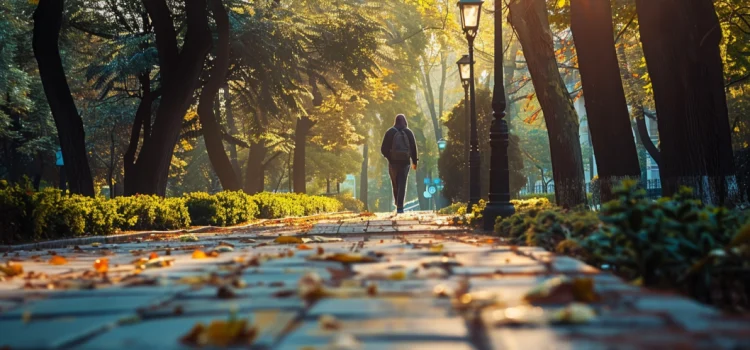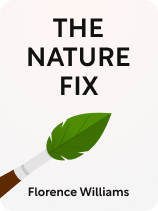

This article is an excerpt from the Shortform book guide to "The Nature Fix" by Florence Williams. Shortform has the world's best summaries and analyses of books you should be reading.
Like this article? Sign up for a free trial here.
Why should you go outside more often? What can you do if you live in a city? Why are green spaces so important?
In her book The Nature Fix, Florence Williams stresses the importance of spending time outdoors. Whether that means taking a walk in a city park or camping in solitude, you need to get out for your mental health.
Here’s why you need to spend more time outside, according to Williams.
How to Improve Our Health and Well-Being Through Nature
Given nature’s many benefits, what’s a city dweller to do? Simply spend more time in it: Williams says the longer we spend outdoors, the more we’re mentally, physically, and emotionally restored—that’s why you need to spend more time outside. She recommends aiming for at least five hours a month, with small daily doses of nature at a city park. Spend weekends away from the cacophony of the city, and once a year (or every other year) take an immersive trip out to the wilderness for a few days.
(Shortform note: Williams recommends regular daily doses of nature and days-long wilderness trips, but more than 160 years ago, one writer took the more extreme step of moving to the woods for two years to connect with nature. In Walden, Henry David Thoreau details his time living in a cabin he built by Walden Pond, away from industrialized society. He describes how he paid attention to the natural world without an ulterior motive and was awakened, inspired, and sustained by nature’s cycle of seasonal change and growth—never mind that he was also sustained by the dinners he often had in town at his mother’s house.)
To make the most of your time in nature, Williams offers additional tips. First, go gadget-free. Ditch the earbuds so you can tune into the healing sounds of nature, and leave your phone behind—Williams explains that talking on your phone while you’re outdoors means you aren’t disconnected from the worries of daily life. Second, choose safe areas where you can relax. Williams explains that it’s difficult to unwind if safety is a concern; women, especially, don’t feel as safe as men do when they’re by themselves in more secluded areas, so take precautions and consider group activities and well-populated trails.
| Do You Really Need to Go Off the Grid? Williams recommends leaving your gadget at home when you’re outdoors so that you can unplug from the worries of daily life, but some believe that it’s more than that: They think it’s necessary to go gadget-free to maintain the pureness of the outdoor experience, and they feel so strongly about it that they resort to tech shaming those who use gadgets. Purists may judge others for having their earbuds on or taking a selfie on a mountaintop, which can ultimately discourage others from venturing outdoors. However, one study suggests that gadgets don’t negatively affect users’ outdoor experience. What’s more, Williams’s two tips may be at odds: Phones are a safety measure, enabling people to find the safest routes and communicate with loved ones in case of emergencies. So what’s the takeaway? Try to use tech to enhance your outdoor experience rather than detract from it, and make sure your gadget use isn’t disrupting someone else’s experience. (Listening to music through your earbuds while you walk? OK. Having music blaring through your speaker at a campsite? Not OK.) If you’d really prefer to leave your phone behind but are wary about hiking or camping alone, consider a non-human companion: A dog can help keep unwanted company away. |
However, there’s only so much we can do on our own—we can’t enjoy nature if it’s not accessible to us. Williams says those who oversee schools, hospitals, and neighborhoods should take a more conscious approach to incorporating nature into their environments. Governments can take inspiration from places like Singapore, Japan, and Finland, which encourage their citizens to spend time outdoors by protecting green spaces and developing walking trails and other nature facilities.
(Shortform note: For places that have bulldozed forests to erect cities, Finland’s forest-preservation approach may not be feasible. But Singapore and Japan have plans and programs that other countries can consider emulating. Singapore has its Green Plan, aiming to plant one million trees and have every household within a 10-minute walk of a park by 2030. And Japan popularized the Miyawaki method of rewilding, which involves planting mixes of native plants that could grow into forests in a matter of years instead of decades. The method has spread to other countries like India, Brazil, and France.)
Within cities, says Williams, even having more trees and courtyards in neighborhoods can help alleviate stress, reduce aggression, and bring people together outdoors. This consequently reduces crimes and strengthens ties within communities—showing that nature’s nurturing powers go beyond individual health.
(Shortform note: Introducing more green spaces to communities can reduce crime rates and strengthen ties, as Williams suggests, but this may also drive out the residents the green spaces are intended for. That’s because improving a neighborhood by adding, maintaining, or restoring public green spaces can increase real estate values, pricing out and displacing vulnerable communities and leading to green gentrification. Experts thus argue that greening projects must go hand in hand with policies that protect the community, taking into account factors like equity and affordable housing.)

———End of Preview———
Like what you just read? Read the rest of the world's best book summary and analysis of Florence Williams's "The Nature Fix" at Shortform.
Here's what you'll find in our full The Nature Fix summary:
- Why humans have an innate affinity for nature
- How some countries are supporting their citizens’ health by giving them better access to nature
- Why the antidote to many of our physical and mental ailments is a good dose of the outdoors






